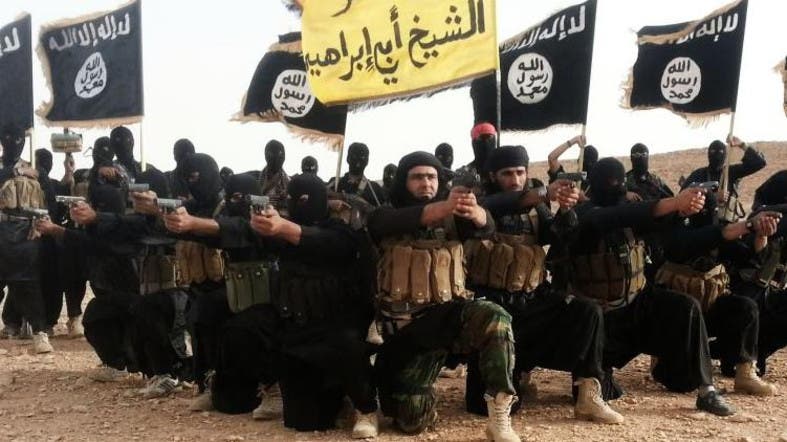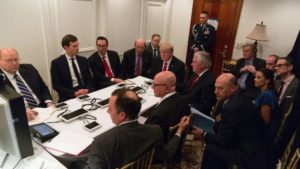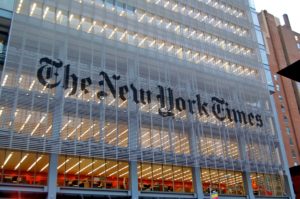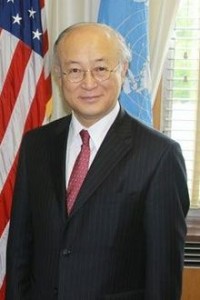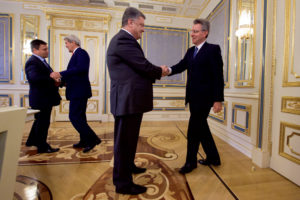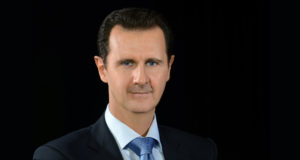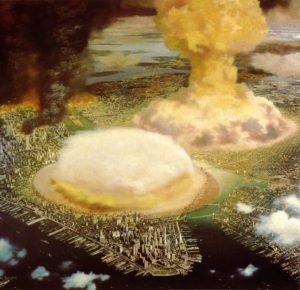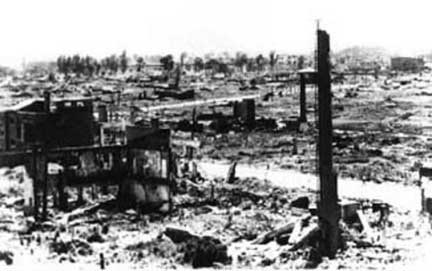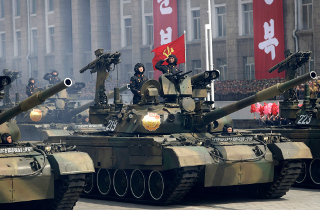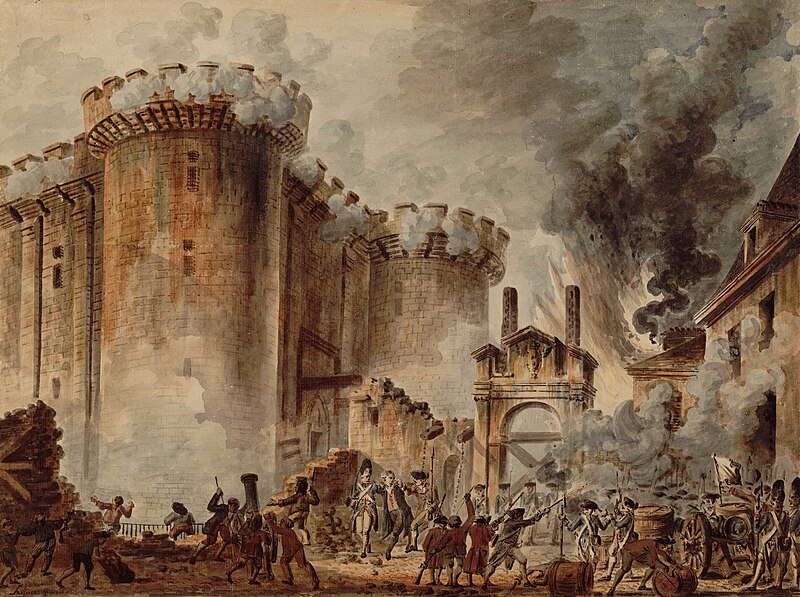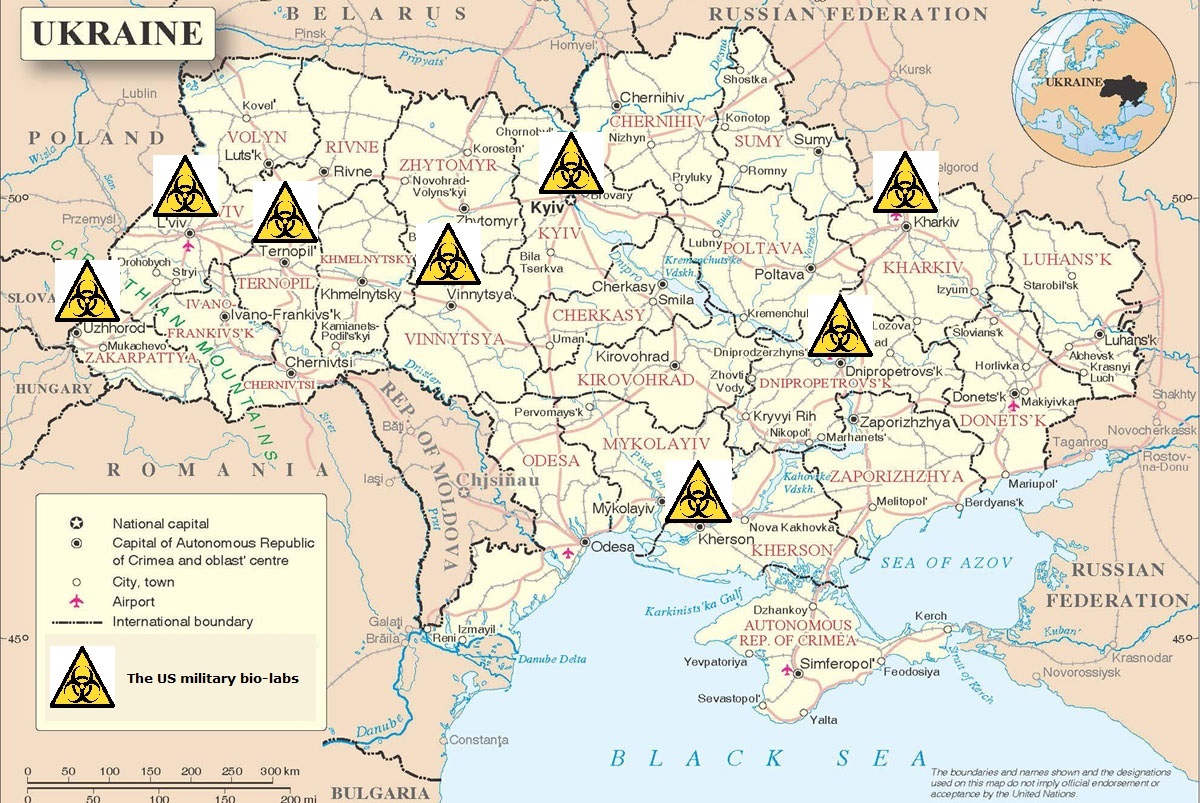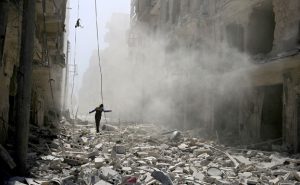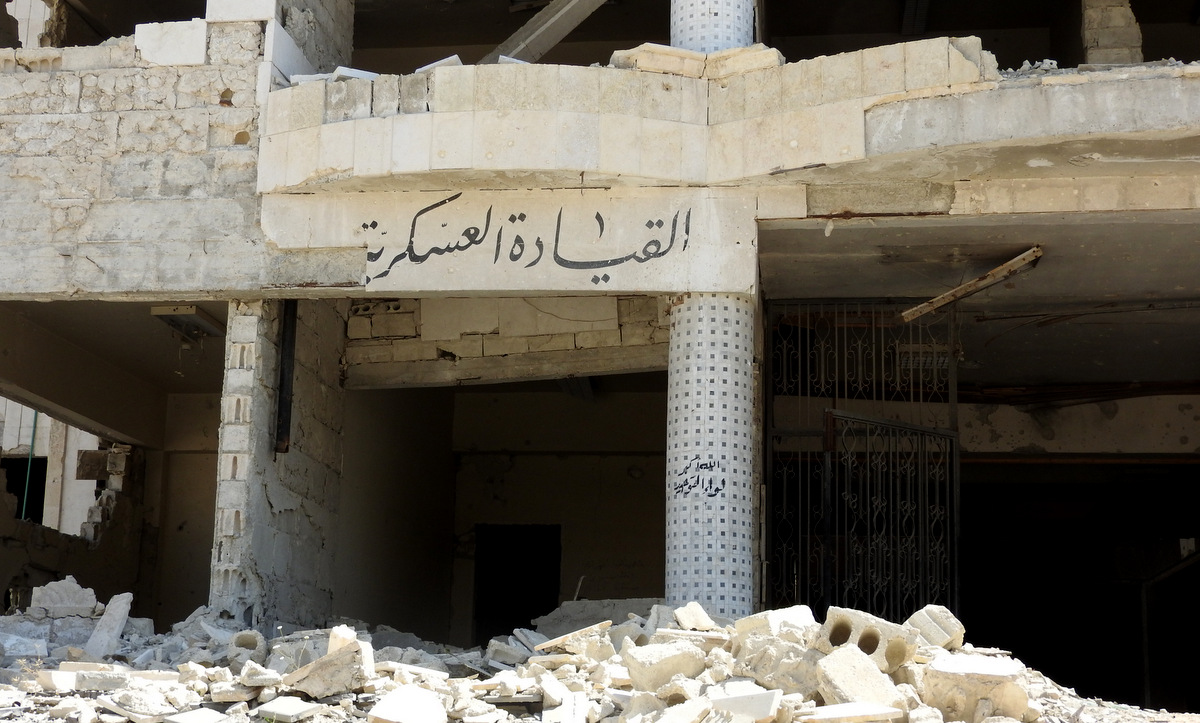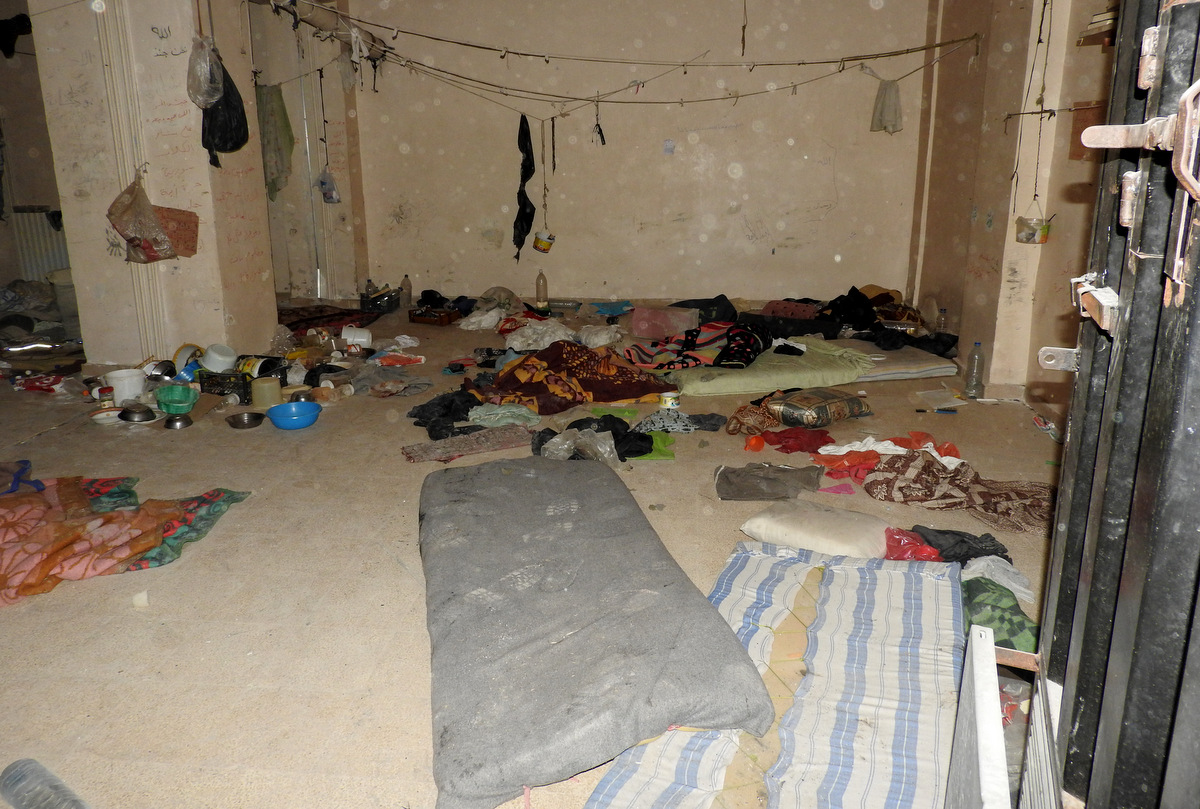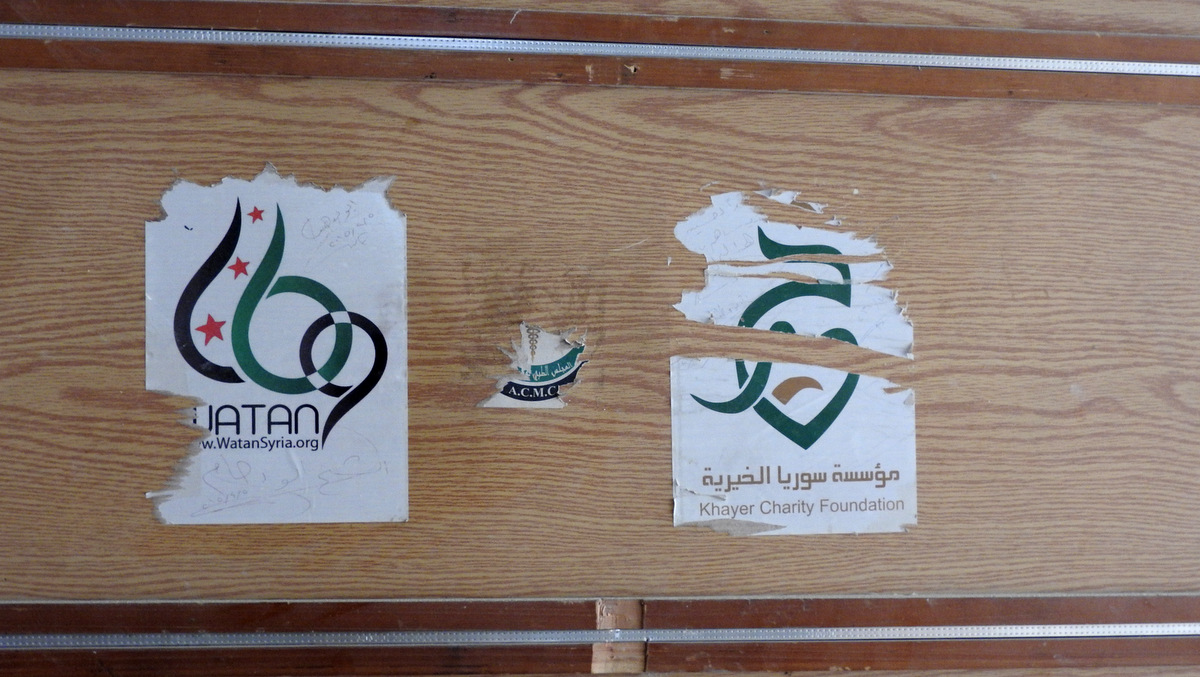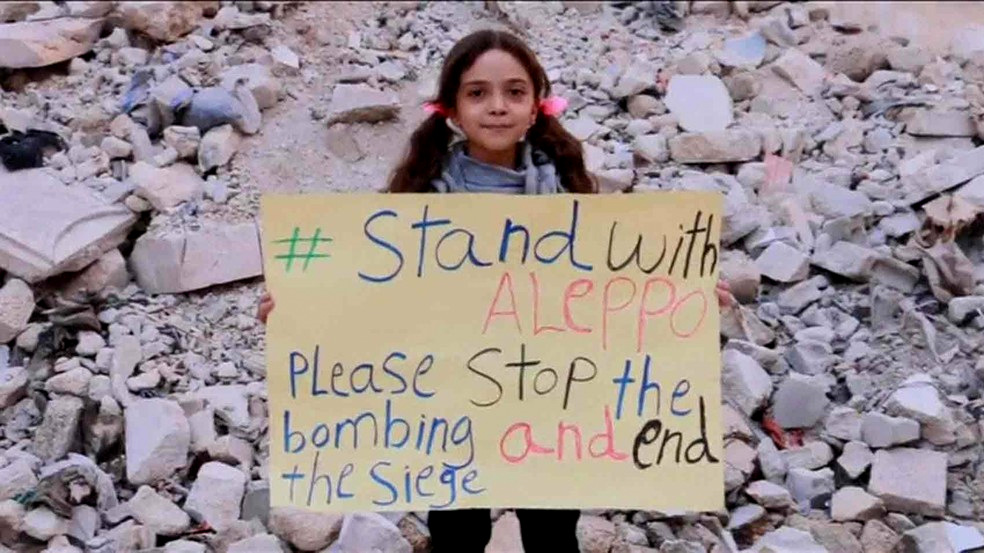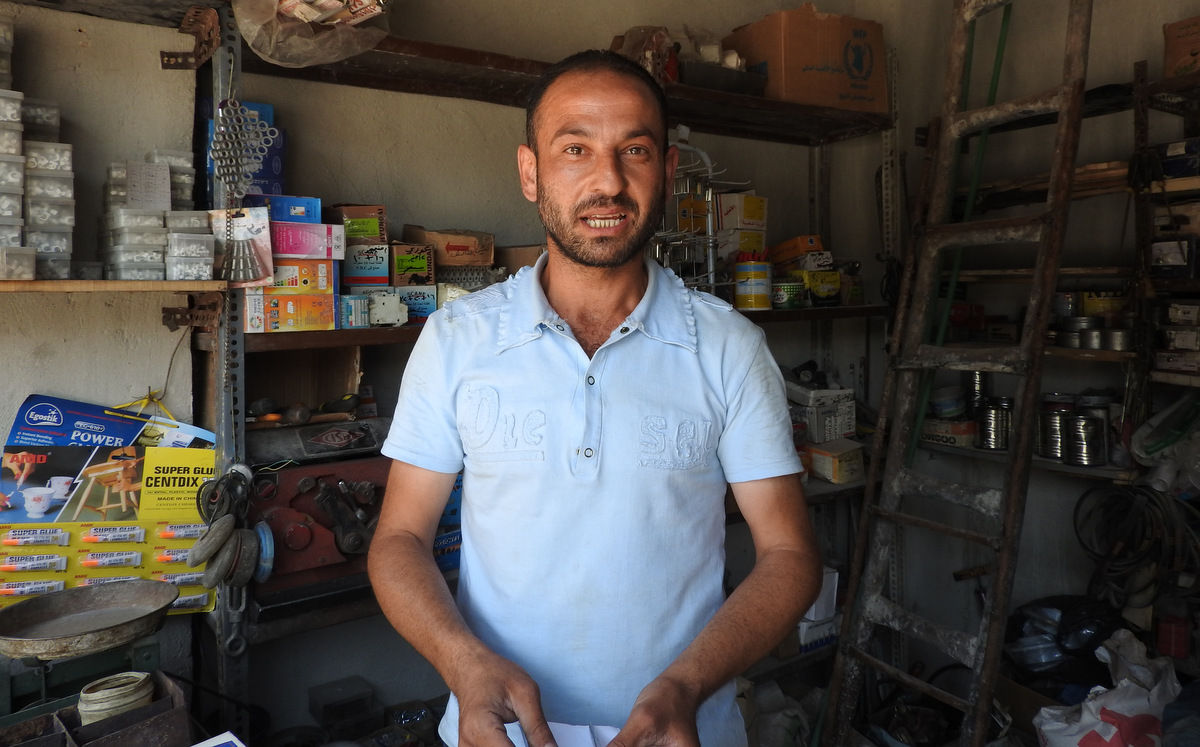Featured image: Logo of the Gulf Cooperation Council (GCC)
It is tempting, and not entirely inaccurate, to dismiss the escalating crisis between Qatar and a number of its neighbors as a petulant princely playground spat. Extending this tempting logic, one could conclude that decisive victory by each of the protagonists would be the optimal outcome. Yet the dispute also reflects deeper dynamics in Arab and regional politics that are shaping the increasingly turbulent and violent realities of the Middle East.
Saudi Arabia’s Gulf Cooperation Council
The Gulf Cooperation Council (GCC), which is the locus of the present crisis, was established in 1981 by Saudi Arabia, Bahrain, Kuwait, Oman, Qatar, and the United Arab Emirates (UAE). Its formation consummated the expiration of the concept of collective Arab action that the League of Arab States aspired to but was designed never to achieve, and presaged the pre-occupation of the region’s regimes with confronting Iran rather than Israel. Although formally established to promote greater economic, political, and security coordination among its member states, the impetus for the GCC’s formation was the collective threat presented to its members by both the 1979 Islamic Revolution in Iran on the eastern littoral of the Persian Gulf and the Iran-Iraq War, launched the following year by Saddam Hussein, whose efforts the Gulf Arab states supported and bankrolled in intimate coordination with the United States.
In the early 1980s, the only GCC member of consequence was Saudi Arabia–whose size, population, resources, and wealth dwarfed that of the others combined–and, to a much lesser extent, Kuwait. Although Oman, unlike its peers, had not severed relations with Egypt after the latter signed a separate peace with Israel in 1979, the prospect that GCC members would even contemplate pursuing a regional or foreign policy independent of Saudi Arabia in those days would have been considered beyond the realm of fantasy. It is for example inconceivable, after blowback struck and Iraq occupied Kuwait in 1990, that Qatar or Bahrain would have opted for a negotiated settlement of the crisis rejected by Riyadh (and its patron in Washington). Nor could they have permitted the United States to deploy troops and establish military bases on their territory had the Saudis not led by example and consented to such moves.
During the 1990s, this equation began to gradually change. The Iran-Iraq, Kuwait, and Cold Wars were over, the price of oil slumped, and the United States maintained a growing and seemingly permanent military or naval presence within every GCC state. Riyadh, in addition to its relatively diminished strategic importance and ailing, sclerotic leadership, was also dealing with the substantial debts it had incurred–again in intimate coordination with the United States–to assemble and fund the coalition of states that evicted Saddam Hussein from Kuwait. By contrast, Dubai, with its diversified economy fueled in part by extensive sanctions-busting trade with Iran, and never lacking for gaudy ambition, was well on its way to becoming a global city and replacing Kuwait as regional trendsetter. In 1995, Qatar, which even many Arabs would in those days have struggled to find on a map, made the news when its amir was overthrown by his son, Shaykh Hamad bin Khalifa Al Thani, in a bloodless palace coup while yet again vacationing in Switzerland.
A Coup in Doha
Much like Oman after Sultan Qabus seized the throne from his primeval father in 1970, Hamad embarked on a program to transform his country into a late twentieth-century state. Unlike Oman in the 1970s, Qatar was neither in the throes of a decade of armed insurrection (Dhofar) nor shared a border with a communist neighbor (the People’s Democratic Republic of Yemen), and could therefore proceed at a measured, deliberate pace. The new ruler of Doha was additionally able to finance his efforts with the proceeds of the as yet undeveloped North Dome/South Pars natural gas field, the world’s largest by several orders of magnitude that it shares with Iran. Production began in 1997, and within a decade Qatar became the world’s leading exporter of liquefied natural gas (LNG), accounting for almost a third of global supply.
In a different contrast with Qabus, Hamad’s seizure of power was not sponsored by the United Kingdom or other foreign power, thus giving regional discontents–first and foremost Saudi Arabia–the opportunity to reverse this affront to seniority and established conventions of succession. A foiled attempt to restore the ousted amir in 1996 and an additional bid to depose Hamad in 2005 further demonstrated that the construction of modernized states in the GCC region was an infrastructural and administrative rather than political project. Several thousand members of the Bani Murra, whose territory straddles the Saudi-Qatari border (where clashes over unresolved border issues had erupted as recently as 1992), had their citizenship revoked after several of their number were implicated in the attempted counter-coups.
Shaykh Hamad quickly set to work to reduce his vulnerability. Approximately one billion US dollars was invested in the expansion of Al Udeid Air Base so it could accommodate every aircraft in the US fleet. When the US military’s Central Command (CENTCOM), whose area of responsibility covers more than four million square miles on three continents, vacated Prince Sultan Air Base in Saudi Arabia to reduce the political exposure of the House of Saud after 11 September 2001, it was invited to establish its forward operating headquarters in Al Udeid. The US military presence, with some ten thousand personnel today its largest in the Middle East, provided protection from both Iran and Saddam Hussein’s Iraq. More importantly, it also served to deter Saudi designs on its tiny neighbor, which, measuring some 4,500 square miles, is smaller than Yorkshire or Connecticut.
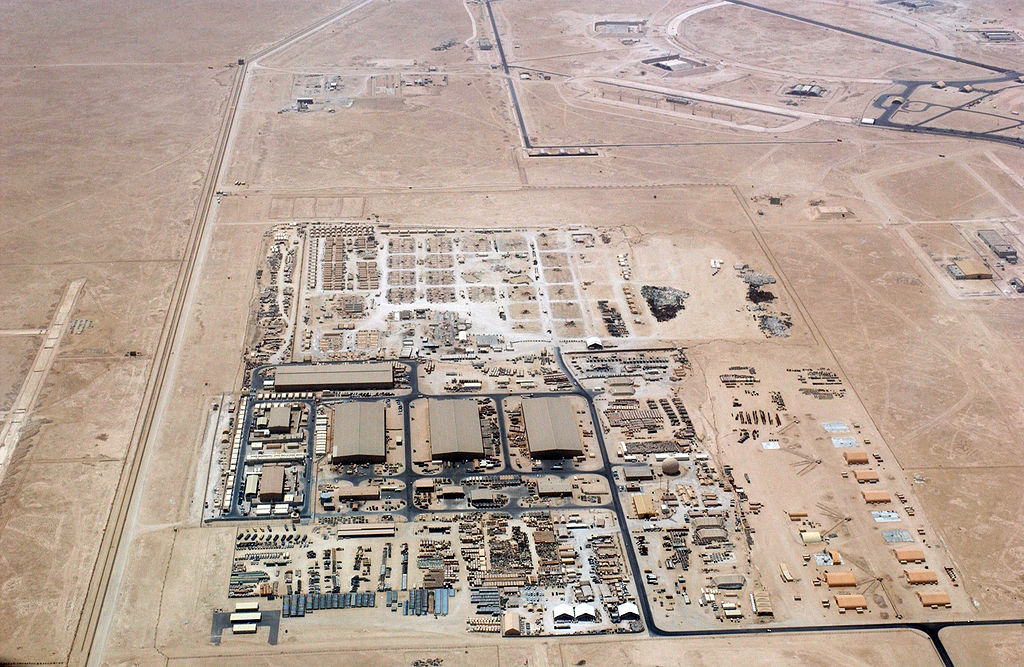
An aerial overhead view of”Ops Town”at at Al Udeid Air Base (AB), Al Rayyan Province, Qatar (QAT), taken from a US Air Force (USAF) KC-135 Stratotanker during Operation IRAQI FREEDOM. (Source: Department of Defense / Wikimedia Commons)
Domestically, Hamad initiated a massive development of Qatar’s physical and financial infrastructure, and of its public services. According to most indices the country today has, at USD 130,000, the highest GDP per capita in the world. Its approximately 300,000 citizens enjoy cradle-to-grave welfare and benefits, while in excess of 1.5 million migrant workers keep its institutions, services, and rapidly expanding construction sector operating at maximum capacity. The Qatar Investment Authority (QIA), the sovereign wealth fund established during the previous decade, is among the world’s best run and resourced. It has purchased iconic locations and prime real estate around the globe, as well as shares in leading corporations such as the London Stock Exchange and Volkswagen. The natural gas that is Qatar’s main export is, in contrast to oil, less prone to sudden price fluctuations, tends to be sold on the basis of long-term contracts that can run decades, and is under significantly less pressure from efforts to deal with global warming and climate change.
Qatar Leaves Home
It was within the region that Qatar made its biggest mark. In the mid-1990s, a joint Arabic-language satellite broadcasting venture between Saudi Arabia and the British Broadcasting Corporation (BBC) came to a premature end after its news station aired reports that violated Riyadh’s strict taboo against critical scrutiny of its policies. Qatar snapped up the suddenly available and professionally trained staff, and less than USD 150 million later it launched the Al Jazeera Satellite Channel on 1 November 1996. Breaking the mold of vacuous reporting by terrestrial channels that specialized in the limitless glorification of mediocre rulers, Al Jazeera was by 1999 providing round-the-clock, free-to-air, high quality satellite news and reporting across the region, and to Arabic-speaking diasporas worldwide. Qatar, its leadership, and foreign policy objectives almost never rated a mention in these broadcasts unless legitimately newsworthy, and doing otherwise would have been superfluous. When some years ago rumors spread that Al Jazeera would be defunded or even shuttered, Shaykh Hamad was reported to have dismissed them with the observation that the broadcaster was of greater value to Qatar than its entire diplomatic corps.
Indeed, Al Jazeera not only offered substantive news coverage but also prioritized issues that spoke to the concerns and aspirations of Arabs from Marrakesh to Muscat, and it was common knowledge that this had been made possible by Qatar’s rulers. It also pioneered deeply unpopular practices, such as interviews with Israeli government officials responsible for perpetuating the occupation of Arab territory. On the whole Al Jazeera offered a refreshingly broad range of perspectives, as a result of which eight Arab states and Ethiopia at one time or another recalled their ambassadors from Doha. Yet those promoting or sympathetic to the Muslim Brotherhood and other Islamist currents seemed to be consistently over-represented in its broadcasts. One such figure was Yusuf Al-Qaradawi, the influential exiled Egyptian cleric who has resided in Qatar since the 1960s and serves as Chairman of the International Union of Muslim Scholars. Widely viewed as the Brotherhood’s pre-eminent theologian, he for many years had a one-hour program on Al Jazeera every Sunday evening. Entitled Shari’a and Life, it habitually strayed beyond matters of faith to offer Al-Qaradawi’s views and prescriptions on current events.
Many Muslim Brotherhood leaders and rank-and-file members had found a home away from home in Saudi Arabia and other Gulf states, where political parties are strictly prohibited, after Egypt’s Gamal Abdel Nasser and other republican, nationalist regimes expunged them from their body politic beginning in the 1950s–in some cases defining mere membership as a capital offense. Although the Brotherhood as an organization does not share the Salafist orientation of its new hosts, it was a valuable ally to the conservative monarchies and their Western sponsors during the Arab cold war that was raging across the region. Its members were also an important source of skilled labor in the teaching profession and other sectors requiring linguistic or religious proficiency, at a time when the local labor force was still unable to meet such needs. In the 1980s, as Islamist activism took an increasingly militant turn, the Muslim Brotherhood played an important role in funneling fighters away from their home countries to the anti-Soviet Jihad in Afghanistan that Riyadh and Washington alike came to view as their finest hour.
The relationship began to sour during the 1980s, with the emergence of the Sahwa movement in Saudi Arabia. Combining Salafist thought with Muslim Brotherhood politics, it was a persistent thorn in the authorities’ side. These tensions culminated during the early 1990s, with the Brotherhood’s failure to embrace Riyadh’s acquiescence in the stationing of western troops on its soil during the Kuwait Crisis which was subsequently deemed an act of disloyalty and ingratitude, and additionally an implicit challenge to the House of Saud’s Islamic credentials.
By replacing Riyadh as chief patron of the region’s largest and best-organized opposition force, Shaykh Hamad was able to snap up yet another vehicle for projecting his country’s influence. (Salafi Jihadi movements, which during the 1990s would come to openly advocate the violent overthrow of not only the region’s secular republics but also its “apostate” monarchies, were less tolerated. Yet GCC rulers–presumably hoping to keep the peace–tended to turn a blind eye to sympathetic subjects who, as during the Afghan jihad, continued to funnel money and other forms of support to al-Qa‘ida and other such groups.) Although Qatar is the only other Muslim state that has elevated Salafism to official religious doctrine (Doha’s main mosque is named after Muhammad ibn Abdul Wahhab, the rigidly puritanical eighteenth-century cleric and co-founder of the Saudi state), few of the grim practices that are government policy in Saudi Arabia are enforced in Wahhabism’s second home.

His Excellency Sheikh Hamad Bin Jassim Bin Jabr Al-Thani, Prime Minister and Minister of Foreign Affairs for the State of Qatar (Source: Wikimedia Commons)
By 2010, Doha had successfully escaped from Riyadh’s formerly lightproof shadow. Another Hamad, Shaikh Hamad bin Jasim Al-Thani (commonly known in the West as HBJ), had been a key player in this regard. A cousin of the amir, HBJ had served as Qatar’s foreign minister since 1992, and in 2007 became its prime minister as well. Concurrently the head of the QIA, his business activities and resultant fabulous personal wealth led the amir to quip that while he ruled the country, HBJ owned it. Another prominent Qatari during this period was Shaikha Moza bint Nasir Al-Masnad, the second and most influential of the amir’s three wives. From her perch atop the philanthropic Qatar Foundation, she personified the country’s soft power. Together Moza and the Qatar Foundation sponsored leading international universities and institutions to set up branches in Doha, and established a string of non-governmental organizations to promote freedoms and values across the region rejected and suppressed within Qatar.
Within little more than a decade, such efforts began to pay off. In 2008 Doha successfully brokered an end to a political crisis that had plagued Lebanon for over a year, facilitated by generous payments to its numerous protagonists. It similarly sought to mediate a peace agreement in Darfour, a ceasefire between the Yemeni government and the Houthi movement, as well as one between Djibouti and Eritrea over a border dispute that led to the deployment of Qatari peacekeepers to the Horn of Africa. On more than one occasion, it sought to displace Egypt as sponsor of reconciliation efforts between Mahmoud Abbas’s Palestinian Authority and Hamas, the Palestinian branch of the Muslim Brotherhood.
When in early 2009 the Arab League, under Saudi and Egyptian pressure, refused to convene an emergency summit in response to Israel’s brutal assault against the Gaza Strip, Qatar, partial to Hamas which had since 2007 ruled Gaza, organized an alternative gathering in Doha in support of the Palestinians. The two Hamads used the considerable powers of persuasion and resources at their disposal to call in favors, outbid Saudi offers to boycott the meeting, and exploit the region’s deepening rivalries. In the end, political realities prevailed and the conclave fell short of a quorum, in part because no other GCC state (or Arab League official) saw fit to defy Riyadh. For good measure, Doha had assigned the Palestinian seat at the conference table to Hamas leader Khalid Mashal after PLO Chairman Mahmoud Abbas begged off, citing irresistible pressure to forsake his people during their hour of need. Iran’s Mahmoud Ahmadinejad and a representative of Venezuela’s Hugo Chavez flew in to address those present. Qatar also announced the closure of the trade office Israel had maintained in Doha since 1996, and in subsequent years began to slowly downgrade what had been an increasingly public relationship with the Israeli government at the most senior levels (though Shimon Peres would again make an “unofficial” visit in 2007).
If the Hamads had done well by Qatar, their achievements prior to 2010 would also be easy to exaggerate; a self-assured UAE had similarly poked Riyadh in the eye in 2009 when it scuttled plans for a GCC monetary union after Saudi Arabia used its clout to locate the proposed central bank in its capital rather than Dubai. More notably, Oman several years later hosted secret American-Iranian negotiations that would in 2015 result in the Joint Comprehensive Plan of Action (the Iran nuclear agreement). While Qatar had successfully placed itself on the map and was adeptly punching above its weight, only the most paranoid potentate considered its activities a threat to the regional order. It was, after all, part and parcel of this order.
Hubris
As with so much else, things began to change with the era of upheaval the Arab world entered in December 2010. As the Muslim Brotherhood used its organizational experience and acumen to enter government in Egypt, Libya, Morocco, and Tunisia, and carve out a leading role in the Syrian opposition, Al Jazeera became the official broadcaster of the Arab uprisings. It seemed to take particular glee in the downfall of Egypt’s Hosni Mubarak, whose intelligence services had participated in the aborted 1996 coup to restore Shaykh Hamad’s father to power. Within a month Yusuf Al-Qaradawi returned to Cairo and delivered the Friday sermon in Tahrir Square. Attended by hundreds of thousands, it was simultaneously broadcast on Egyptian state television and of course Al Jazeera.
Qatar was suddenly the most influential member of the Arab League, engineering its endorsement of foreign military intervention in Libya, in which it participated, as well as the suspension of Syria’s membership and transfer of its seat to Doha’s protégé, the opposition Syrian National Council. When the Syrian uprising against nearly half a century of Ba’thist rule metamorphosed into civil war, Qatar was a leading financier and supplier of the armed opposition groups that emerged throughout the country. It seemed the entire region was being remade, if not in Qatar’s image, then at least in accordance with decisions made in Doha. The mouse was audibly roaring. In 2010 Qatar even succeeded–widespread allegations of bribery notwithstanding–in winning the rights to host the 2022 FIFA World Cup. In 2013, acting with US consent, it invited the Afghan Taliban to open an office in Doha to facilitate negotiations to end the conflict in central Asia.
Doha’s indulgence of challenges to the region’s ancien régimes also had clear limits, particularly as the unrest spread closer to home. It endorsed and supported the Saudi-led 2011 GCC intervention in Bahrain to crush popular protests against the highly repressive Al Khalifa monarchy, and that same year signed on to a GCC plan for Yemen that saw President Ali Abdallah Salih transfer power to his deputy rather than cede it to those seeking to install a new and different kind of political system. Disturbances in Saudi Arabia’s oil-rich, Shi’a-majority Eastern Province were also pointedly ignored.
Similarly, Qatar’s rulers, as thin-skinned and absolute in their powers as their GCC counterparts, did not hesitate to jail domestic critics inspired by regional events. In 2011, local poet Muhammad al-Ajami received a life sentence for the crime of lèse-majesté on the basis of several verses he had composed. The Doha-based Arab Democracy Foundation, which specialized in bombastic declarations about how the will of Arab peoples elsewhere would never be defeated, had not a word to say on the matter, while the Doha Centre for Media Freedom made do with an expression of “concern.” Nary a peep emanated from the numerous foreign institutions that had accepted Qatari largesse; many had done so with all but a formal communiqué implying they were motivated by the opportunity to civilize a new generation of Arabs. (Al Ajami received a royal pardon in 2016.) More recently the abysmal conditions experienced by migrant workers building the facilities for the 2022 World Cup has become an international scandal, but one that journalists in situ find almost impossible to investigate.
Several factors helped Qatar achieve a role out of any proportion to its geography, demography, or even economy. Egypt had for some time ceased to fulfill its traditional leadership role in the Arab world. In Saudi Arabia, the waning years of King Abdallah’s reign were characterized by an increasingly dysfunctional and divided Saudi elite often incapable of formulating a consistently coherent foreign policy and keeping other GCC members in line. Qatar’s closest regional ally, Recep Tayyip Erdogan of Turkey, by contrast suffered from an excess of clarity and ambition, commanded one of the region’s largest and most powerful states, and unlike his predecessors took a keen interest in the Middle East. Turkey’s ruling Justice and Development Party (AKP) additionally had much in common with the Muslim Brotherhood, and promoted itself as a model for the latter’s various Arab branches as they tried their hand at governance. Finally, Qatar took a pragmatic approach to foreign affairs. It maintained relationships with both Israel and Hamas, the United States and Russia, Saudi Arabia and Iran.
Nemesis
In almost dialectical fashion, Doha’s moment of triumph also sowed the seeds of its unraveling. By 2012 the reputation of Al Jazeera Arabic offerings, now serving as an undisguised soapbox for ever more explicit Qatari foreign policy goals and the various allies and proxies mobilized to achieve them, was diminishing rapidly. As the saying goes credibility takes years to build, is sacrificed in an instant, and once lost is gone forever. (Al Jazeera English, whose relevance to regional politics is minimal, by contrast largely continued as a conventional news broadcaster.)
The ascendant Muslim Brotherhood, with its very different conception of Islamist politics to that practiced by Gulf regimes, its promotion of the ballot box as arbiter of political power, and growing role in government, was perceived as an existential threat by the region’s hereditary rulers. So too was the possibility that more militant Islamists groups, which openly challenge the potentates’ religious credentials and which called for their heads, might gain in strength. Where the custodians of the regional order had heretofore prioritized containing Iran–a project in which various Sunni Islamist organizations could play a useful role–they now focused primarily on restoring the regional status quo, in which such organizations would need to be removed from power and their Qatari and Turkish sponsors marginalized. (With many specialists convinced that the Brotherhood would easily sweep a theoretical election in Saudi Arabia, King Abdallah declared it his country’s main enemy).

Anti-Morsi demonstrators marching in Cairo, 28 June 2013 (Source: Wikimedia Commons)
A key turning point was the 2013 coup that deposed elected president Muhammad Morsi and his government in Egypt, the Arab world’s most populous and pivotal state. The seizure of power replaced the Muslim Brotherhood with a military regime led by Abdel Fattah al-Sisi, who was determined to eradicate it. It also represented a shift from a Qatari client to one virtually dependent on Saudi and Emirati patronage for survival. Egypt re-imposed its blockade on the Gaza Strip, now exponentially more severe than anything enforced during the worst days of Mubarak; Tunisia’s Islamists voluntarily stepped out of government; and Qatar’s candidates began to fall short in Syrian opposition leadership elections.
Within the Gulf, the campaign reached its apex in the UAE where al-Islah, an association established by exiled Brotherhood members that had been licensed by the authorities during the 1970s, was accused of establishing a clandestine military organization to seize power in the country. The trial of ninety-four purported plotters resulted in the sentencing of fifty-six of them. If it was a sham, it was no show trial; a relative of one defendant was imprisoned for tweeting about the proceedings. In 2014, both Saudi Arabia and the UAE listed the Muslim Brotherhood as a terrorist organization.
A week before al-Sisi’s coup, Shaykh Hamad suddenly abdicated in favor of his–and Moza’s– thirty-three-year-old son, Tamim. Although Hamad had undergone two kidney transplants, health reasons were neither cited nor convincing as an explanation. According to some reports, it was part of an informal deal with Riyadh and other GCC detractors whereby the amir’s departure would ensure that the furious Saudi-led counterrevolution would not consume the Al-Thani family, who were perceived as chief sponsors of regional instability. Others surmised that the voluntary transfer of power to a new generation was a final, two-fingered salute directed at the octogenarian monarch next door, whose trusteeship Hamad had spent most of his career defying. Perhaps it was both. In the event, Shaykh Hamad took HBJ with him into retirement, as the latter’s prominence and power would have made it impossible for Shaikh Tamim to rule in his own right.
Whether Riyadh and Abu Dhabi believed the new amir was as errant as his father, wanted to test the youngster’s mettle, or were simply determined to ensure Qatar would once again play by old rules, crisis ensued in March 2014. In a prelude to the current dispute, Saudi Arabia, the UAE, and Bahrain withdrew their ambassadors from Doha and threatened further measures if Qatar did not correct its conduct. Tamim was said to have reneged on commitments undertaken at a 2013 GCC summit relating to the preservation of regional security and stability, hostile media, and members’ non-interference in each other’s affairs–concepts so broad they could encompass a poor restaurant review.
Within months the dispute was overtaken by a more urgent crisis when the Islamic State movement swept from northeastern Syria into northwestern Iraq and its second city of Mosul, declaring a caliphate. Reports that negotiations between Iran and the United States over the nuclear file were making unprecedented progress towards an international agreement additionally spurred the GCC to close ranks. On the strength of various understandings, a new document that restated the 2013 commitments, and Qatar’s expulsion of a number of Brotherhood leaders and cadres, Kuwait successfully mediated a November 2014 return of the recalled ambassadors to Doha. Yet the underlying tensions that had been building over nearly two decades remained unresolved.
The Reinvention of Saudi Arabia
In January 2015, Saudi Arabia’s King Abdallah, who had effectively ruled the country since his predecessor and half-brother Fahd was incapacitated in 1995, breathed his last. The kingdom’s founder, King Abdulaziz (commonly known as Ibn Saud), had fathered over forty sons from numerous marriages. Although Ibn Saud passed the crown to one of his sons, succession since then has proceeded horizontally among siblings rather than vertically between generations. With nature steadily depleting the supply of available candidates (two of Abdallah’s half-brother crown princes died within the space of a year), the monarch established the Allegiance Council (a princely consultative body) in 2006 as well as the position of deputy crown prince in 2014, to ensure a consensual and therefore smooth transition to the next generation. Such measures were necessary because, in contrast to traditional monarchies, every one of Ibn Saud’s numerous grandsons, rather than just the offspring of the last of his sons to occupy the throne, are eligible for the succession, thus multiplying the possibility for rivalry and royal conflict within the world’s largest oil exporter.
When Salman became king in 2015, he appointed his half-brother Muqrin as crown prince and his nephew, the powerful interior minister (and Washington’s favorite Saudi) Muhammad bin Nayif, to the position of deputy crown prince. It was the first time a member of the third generation had been placed in the line of succession, and the seeming absence of widely-anticipated dissent appeared to vindicate the measures Abdallah had taken before his death.

Saudi Crown Prince Mohammad bin Nayef (L) and Deputy Crown Prince Mohammad bin Salman (R)
A mere three months later, however, King Salman ousted Muqrin, promoted Muhammad bin Nayif to crown prince, and appointed his own twenty-nine-year-old son, Muhammad bin Salman (often referred to as MBS) as deputy crown prince. The supreme offices in the kingdom were now concentrated in a branch of the House of Saud descended from only one of Ibn Saud’s wives, Hissa Al-Sudairi, whose sons–including former King Fahd, former Crown Prince and Defense Minister Sultan, former Crown Prince and Interior Minister Nayif, and King Salman–are known as the Sudairi Seven. Not less importantly, the royal reshuffle strongly suggested that the ailing Salman sought to pass the crown to his own progeny, thereby transforming Saudi Arabia into a “regular” monarchy.
Almost immediately, MBS began to amass powers to rival a monarch, including Minister of Defense, Chairman of the newly-established Council for Economic and Development Affairs, and head of the newly-created Aramco Supreme Council, effectively usurping energy policy from the Ministry of Energy, Industry, and Mineral Resources.
The following year MBS unveiled Vision 2030, a blueprint inspired by McKinsey & Company consultants that sought to transform the Saudi economy (and by implication, society) in response to the prolonged decline in oil prices since the US shale industry burst onto the scene. A centerpiece of the plan, which has been highly controversial domestically and within royal circles as well, calls for the sale of five per cent of Saudi ARAMCO, the state-owned oil company valued at between USD 1-2 trillion that is the jewel in the Saudi crown. The proceeds, in combination with savings resulting from various reforms and austerity measures, are to be leveraged to achieve a catalogue of utterly preposterous targets including a five-fold increase in non-oil government revenue, a five-fold increase in the non-profit sector’s contribution to GDP, a fifty per cent expansion of the private sector, and an increase in life expectancy by six years–all by the end of the next decade. Vision 2030 was also clearly designed to serve the more attainable objective of enabling MBS to leapfrog his cousin Muhammad bin Nayif in the line of succession before his father’s death.
That MBS was determined to fling the traditional Saudi policy-making process to the wind was even more evident in foreign affairs. The days in which Riyadh carefully crafts a domestic, regional, and international consensus before leading a change in direction from behind were replaced with aggressive recklessness. According to a leaked report authored by the German intelligence service BND:
The previous cautious diplomatic stance of older leading members of the [Saudi] royal family is being replaced by an impulsive policy of intervention … [MBS] is a political gambler who is destabilizing the Arab world through proxy wars … [His concentration of power] harbors a latent risk that in seeking to establish himself in the line of succession in his father’s lifetime, he may overreach … Relations with friendly and above all allied countries in the region could be overstretched.
This was most clearly evident in Yemen, where within months of becoming the world’s youngest defense minister, MBS unleashed a war supported (among others) by Qatar and the United States, to restore the government of Abd-Rabbu Mansur Hadi that had been ousted by Houthi rebels working in alliance with former president Salih.
But instead of resulting in the quick and decisive victory that would bolster his military and leadership credentials, the war on Yemen has developed into an ongoing quagmire that has fragmented and effectively destroyed the country, killed many thousands of civilians, and made Yemen a first-order humanitarian emergency. It has inflicted material as well as human losses on Saudi Arabia, and additionally enabled Yemeni incursions and missile attacks into Saudi territory. As a consequence, MBS appears eager to bring his adventure to an end, but conditions that preserve rather than damage his reputation and ambition have yet to be found.
The Houthi relationship with Iran, much exaggerated but becoming a reality on account of the war, was cited as a key motivation by Saudi Arabia. This reflects a broader shift in Riyadh, where confronting and containing Iran’s growing influence in the region has since the 2014-2015 thaw in US-Iranian relations often taken precedence over marginalizing other Islamists and restoring the status quo disturbed by the Arab uprisings. In Syria, for example, the Saudis put aside their rivalry with Qatar and Turkey over control of the Syrian opposition, and crafted Jaysh al-Fath, a coalition of Syrian rebel groups in which Jabhat Al-Nusra, the Syrian affiliate of al-Qa‘ida, played a leading role. Similarly, an International Crisis Group report published this year found that Saudi Arabia was engaging in “tacit alliances” with al-Qa‘ida in the Arabian Peninsula (AQAP) and “regularly fought alongside” the forces of Ansar al-Shari’a, an AQAP subsidiary. Writing earlier for the Carnegie Endowment for International Peace, Gulf affairs specialist Neil Partrick reached a similar conclusion, and additionally noted that “Saudi Arabia made sure to repair its relations with the MB [Muslim Brotherhood] Islah Party” during the run-up to the war, and that this effort included putting it “back on Riyadh’s payroll.”
Another Gulf State Punches Above Its Weight
Although the UAE has been the most active member of the coalition in terms of committing ground forces to Yemen, it has eschewed alliances with Islamists. This reflects both its congenital hostility to them since 2011 (which also explains its comparative absence from the Syrian theatre), and the reality that its forces operate primarily in areas of the country where the Houthi-Salih coalition has been expelled, and the primary conflict is now between government forces and Islamist militias. The UAE, a federal state comprising seven hereditary emirates in which the ruler of Abu Dhabi, whose territory encompasses eighty-five per cent of the country, traditionally serves as president, was under its founding leader Shaikh Zayid bin Nahyan generally characterized by neutrality in inter-Arab conflicts and a balanced regional policy within a context of deference to Saudi leadership.
More recently it has developed a much more assertive stance. Although the UAE for example does not recognize Israel, the latter is permitted to maintain a diplomatic mission in the UAE capital under the umbrella of the International Renewable Energy Agency (IRENA). The Emirati air force has also conducted joint exercises with its Israeli counterpart in the United States and Greece. Informal security links are said to run extremely deep and include the purchase of Israeli weapons systems and technology.
Spearheading such changes has been Muhammad bin Zayid (MBZ), who has since 2004 been Crown Prince of Abu Dhabi, Deputy Supreme Commander of the UAE armed forces, and the country’s de facto ruler. Early on, he adopted Palestinian warlord Muhammad Dahlan to unseat Hamas after the latter won the 2006 Palestinian Authority legislative elections. Since Dahlan’s defeat in the Gaza Strip and then downfall in the West Bank on account of a personal dispute with his chief patron, Mahmoud Abbas, MBZ has been promoting him as Abbas’s successor. He was appointed national security advisor to the emirate of Abu Dhabi, and conducts various missions on behalf of his new benefactor in Egypt, Libya, Serbia, and elsewhere. (In a more recent twist, Hamas and Dahlan in mid-June reached a number of understandings on cooperation in a joint effort to weaken Abbas. Because their implementation is reliant on Egyptian facilitation and Emirati funding, this effectively puts the UAE and Hamas in the same camp, even as Abu Dhabi points to Qatar’s sponsorship of the Palestinian Islamists as a factor in the present GCC crisis.).
One of MBZ’s most notable achievements has been the development of the UAE special forces into a significant military asset and their deployment across the region. Crucial to this endeavour was Erik Prince, formerly of Blackwater and brother of US Education Secretary Betsy DeVos, and a large contingent of Colombian mercenaries imported by Prince to develop the force. The prince’s contract reportedly netted Prince in excess of half a billion dollars.
UAE ground forces have fought in Yemen to regain territory from the Houthis, and participated in a botched February 2017 raid in conjunction with US Navy Seals to eliminate an AQAP leader that resulted in the killing of numerous civilians. More recently, reports have emerged of horrific torture chambers operated by the United Arab Emirates in Yemen, in what appears to be close coordination with the United States. The Emirati air force has been active against Islamic State movement targets, and as far afield as Libya in support of renegade general (and former CIA asset) Khalifa Haftar. Such adventurism has led US Defense Secretary James Mattis to label the country “Little Sparta.” Even though serving a different agenda and using different instruments, the UAE’s growing regional clout in important respects echoes that of the other small state to its north, Qatar. In a further resonance, Saudi and Emirati forces have recently been working at cross-purposes in Yemen, competing for dominance over various proxies.
When King Salman succeeded to the Saudi throne and immediately set about systematically deposing or marginalizing Abdallah’s courtiers and confidantes, with whom MBZ had maintained close relationships, the elevation of Muhammad bin Nayif to crown prince caused particular concern in Abu Dhabi. A Wikileaks cable that detailed how MBZ had in a discussion with US diplomat Richard Haass compared the Saudi prince’s father to a monkey, caused what might be termed a permanent rupture. The UAE’s comparatively warm welcome of the Iranian nuclear agreement strained matters further.
MBZ rebuilt the relationship by assiduously cultivating the like-minded MBS, who conveniently was together with his father clipping Muhammad bin Nayif’s wings at every opportunity. MBZ was also quick to cultivate Donald Trump after the 2016 election. In December, he flew to New York to meet the president-elect and his key aides at Trump Tower without–contrary to protocol–informing the US government of his visit (according to the Washington Post the White House only learned of it when his name was discovered on a flight manifest). Shortly thereafter, the same newspaper reported, MBZ and his brother brokered a covert meeting between Erik Prince and an associate of Russian President Vladimir Putin in the Seychelles islands in the Indian Ocean, where the UAE has extensive property holdings, to set up a backchannel between the incoming American administration and the Kremlin. MBZ is also said to have arranged for MBS’s audience with Trump shortly after he took office, which in turn resulted in Trump’s May 2017 visit to Riyadh.
Enter Trump
By any measure, the Saudis have played their hand with the Trump administration extremely well. They reached out to his closest associates, provided the new president with the effusive praise that gets his attention, and then sent MBS to Washington to detail the contributions Saudi Arabia can make to both his foreign and domestic agendas. With the new administration’s relationships with its neighbors and traditional allies experiencing various levels of crisis, they succeeded in making Riyadh rather than Mexico City, Ottawa, or London the destination of Trump’s inaugural foreign visit.
The previous November, the Saudis had been eagerly counting the days until Obama would be replaced by Hillary Clinton, and US Middle East policy would revert to its longstanding pattern of intimate partnership with the Kingdom on the basis of a shared regional agenda and pursuit of common objectives, particularly in Syria and Iran. While no less taken aback than the rest of the planet by Trump’s unexpected victory, the Saudi leadership was additionally apprehensive on account of his inflammatory campaign rhetoric against their country, faith, and resources. But this was trumped by the winning candidate’s consistent hostility to Iran on the campaign trail, and the even greater animosity towards it expressed by presidential gurus like Steve Bannon and the incoming national security team.
Demonstrating their influence and authority by convening a GCC and Arab/Islamic summit to supplement the Saudi-US one (the source of Trump’s idiotic claim that history had never witnessed such a gathering and probably never would again), the Saudi leadership announced the formation of a new Islamic coalition (a “Middle Eastern NATO”) against “terrorism,” with Trump as its spiritual godfather; dangled the prospect of an Arab-Israeli peace agreement in front of the US president and his son-in-law; reheated existing deals concluded with the Obama administration, and additionally signed letters of intent for new ones that allowed the new US president to boast that he had secured hundreds of billions of dollars in new contracts; and lost no opportunity to engage in the ostentatious displays of wealth and kitsch that Trump so adores.
The reset in US-Saudi relations was a superlative success, to the extent that Trump virtually held Shi’a Iran responsible for the emergence and growth of Sunni extremist organizations across the region. More importantly, he anointed his new best friend Salman as Washington’s indispensable Arab partner and supreme leader of the Arabs and Muslims. Trump had effectively extended Salman carte blanche to remake the region in accordance with their joint vision of durable security and stability, and appointed him regional commander of the alliance against Tehran. The neglect that had characterized the Obama years, always more a matter of perception than reality, had come to a definitive end, and Riyadh felt empowered and emboldened to reassert its leadership role. In the immediate term, this meant bringing Qatar to heel.
Crisis
During the Riyadh summit, Saudi and Emirati leaders are said to have complained to Trump about Qatari misconduct with respect to Iran and Islamist groups, pointing out that this undermined the key pillars of Trump’s Middle East policy. When the US president relayed these concerns and their source during his separate meeting with the Qatari ruler, Shaykh Tamim reportedly retorted that the US president was barking up the wrong tree, noting that not only al-Qa‘ida but also the Islamic State movement obtain most of their funding and support from Saudi and Emirati sympathizers, and that Dubai additionally serves as the Iranian economy’s main window to the world. Yet only days later Doha, citing irresistible pressures, expelled a number of Hamas military leaders with immediate effect and informed the movement that additional measures may follow.
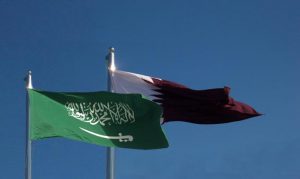
According to the Financial Times, the Saudis and Emiratis were particularly perturbed by a complex deal brokered by Qatar in April of this year to obtain the release of twenty six of its citizens–including at least one member of the royal family–who had been taken hostage in southern Iraq in 2015 by pro-Iranian Shi’a militias while on a hunting expedition. In addition to paying a ransom of some 700 million US dollars to the captors, most of which is said to have ended up in the coffers of the Iranian Revolutionary Guards Corps (IRGC), the hostages’ freedom was made contingent on a population exchange in Syria. The Syrian component of the deal included the evacuation of several thousand Syrian Shi’a civilians from the town of Madaya, where they had for several years been under siege by Syrian Islamist groups including Jabhat Tahrir al-Sham, the recently re-branded al-Qa‘ida affiliate formerly known as Jabhat al-Nusra. With Qatar disbursing an additional 200 million US dollars to the Syrian rebel groups to secure the evacuation, it stood accused of not only directly funding al-Qa‘ida, but engaging in a pattern of using hostage negotiations as cover to fund radical Islamists in Syria in order to promote regime change in Damascus and consolidate its influence over the Syrian opposition. (The operation was exposed when bales of cash totaling hundreds of millions of dollars were discovered in a Qatari plane at Baghdad Airport).
Then, days after the conclusion of the Trump visit, the official Qatar News Agency (QNA) website on 24 May carried statements attributed to Tamim in which he expressed support for Hizballah and Hamas; praised Iran and Israel; denounced Saudi Arabia, the UAE, Bahrain, and Egypt; and disparaged both Trump and the purported deals concluded in Riyadh. Qatar denied its amir had made the statements, claimed the QNA website had been hacked, and called in the FBI to investigate. By then the media war had already begun. The statements were massively circulated and vociferously denounced by Saudi and Emirati-sponsored media, and the circulation and transmission of Qatari-sponsored media were blocked in the offended states. The tone and ruthlessness of the ongoing media campaigns easily matches that of countries that have been engaged in prolonged warfare.
In early June, the email account of the UAE’s Ambassador to the United States, Yusuf al-Otaiba, described by the New York Times as “a personal tutor in regional politics to Jared Kushner”, was hacked. Its embarrassing contents–particularly concerning Otaiba’s calls to relocate CENTCOM’s regional headquarters away from Qatar, his close relationship with the extreme pro-Israel Foundation for the Defense of Democracies, and disparaging assessments of Trump in exchanges with Obama officials during the transition–were prominently publicized by Qatari-owned media.
Immediately thereafter, Saudi Arabia, the UAE, Bahrain, and Egypt on 5 June announced they were severing diplomatic relations with Qatar. In addition to recalling their diplomats from Doha and giving Qatar’s emissaries forty-eight hours to leave, they severed all land, sea, and air links with it; closed their air space to Qatar’s national airline in apparent violation of the Convention on International Civil Aviation; ordered the repatriation within fourteen days of all Qataris residing in their territory as well as (Egyptians excepted) of their citizens living in Qatar; and expelled Qatar from the coalition that has been reducing Yemen to rubble. Because Qatar’s only land border is with Saudi Arabia, through which it obtains forty per cent of its food supply (including more than ninety-five per cent of fruits and vegetables), this has amounted to a virtual blockade. A number of Arab and Muslim recipients of Saudi and Emirati largesse including Jordan, Mauritania, The Maldives, the exiled government of Yemen, and the powerless one of Libya, also announced a downgrading or severance of their relations with Qatar. Jordan additionally revoked Al Jazeera’s operating license.
The following days saw additional measures imposed against Qatar, particularly by the UAE. Qatalum, the aluminum producer jointly owned by Qatar Petroleum and Norway’s Norsk Hydro, was forced to re-route exports from its traditional port, Dubai’s Jabal Ali, to alternatives in Oman. Similarly Qatar, the world’s second largest producer of helium, had to close down production facilities on 12 June because the gas could no longer be exported overland through Saudi Arabia. On 7 June, the authorities in Abu Dhabi announced that any resident expressing opposition to its policy towards Qatar, or sympathy for Doha, faced the prospect of fifteen years in prison and a hefty fine. Saudi Arabia and Bahrain followed suit with similar measures.
The rapidity with which this crisis escalated and intensified has been remarkable. Amidst unverifiable rumors of divisions within the Qatari, Saudi, and Emirati leaderships about their respective handling of events, and even talk of a military option if the political one fails, Kuwait and Oman–the only GCC states that declined to take measures against Qatar–commenced mediation efforts. But tensions were further heightened when President Trump, who appeared unaware that Qatar hosts the largest US military base in the region, in his Twitter account all but took personal responsibility for the campaign against it, presenting it as a signal achievement of his foray into the Middle East to slay the beast of terror. Needless to say, his comments left the State Department and Pentagon scrambling to re-assure Doha that neither CENTCOM’s relocation nor regime change are under consideration.
While details remain scarce, Qatar’s detractors have strenuously denounced “violations” of the agreement that ended the 2014 diplomatic rupture. Although there have been reports of a list of ten demands, others speak only of “grievances.” The Qataris, who insist they will only discuss issues relating to compliance with GCC commitments and only after the blockade has been lifted, for their part maintain that the Kuwaiti and Omani mediators have yet to transmit or be provided with a list of specific violations or demands in this regard.
Whether the expulsion of Hamas from Qatar and the closure of Al Jazeera form an opening gambit or are designed for rejection is difficult to divine, but Qatar’s adversaries initially seemed to be holding all the cards. Doha was forced to rely on Iran and Turkey for food and other imports, and their airspace for its national carrier to remain operational, thus making its conduct only more suspect. Furthermore, a diminished Al Jazeera lacked the credibility and audience it once had to mobilize regional public opinion. Qatar’s currency and credit rating have been in decline, and questions are being raised about its ability to successfully host a World Cup in which it had already invested massively.
Where some observers took the demands made of Qatar seriously, others suggested the specific issues raised were either submitted for propaganda value or are marginal to the real interests of Saudi Arabia and the others. Rather, their purpose is to force Doha to dance to the GCC tune, cut it back down to its miniature size, and ensure that it once again follows the lead of more powerful neighbors rather than pursue an independent regional agenda that too often works at cross purposes with theirs.
Qatar’s fortunes took a sudden turn for the better on 7 June. Trump called Tamim, and during their discussion the US president emphasized the importance of restoring calm and stability to the GCC, invited his Qatari counterpart to the White House, and offered help with mediation efforts–thereby giving the Kuwaiti-Omani mission a vital endorsement. Earlier that day, the FBI announced that QNA had indeed been hacked by Russian parties, but left unstated on whose behalf they may have been acting. That same evening the Turkish parliament—with whom Qatar had in 2016 concluded a mutual defense treaty—adopted a resolution to dispatch an additional three thousand troops to the beleaguered country. The tripwire force that effectively took any military option being contemplated off the table arrived the following week, during a joint military exercise between Qatari and US forces that sent an equally pointed message. Meanwhile a growing chorus of international powers, including Russia, the European Union, and Germany, made clear they need another crisis in the Middle East, this time between its main energy exporters, like a hole in the head. Unsurprisingly, they have consistently pressed for a speedy and peaceful resolution.
Two days later, US Secretary of State Rex Tillerson, presumably in consultation with the White House, issued prepared remarks in which he essentially praised Qatar and its alliance with the United States, while also calling upon it to more rapidly take more effective measures against the “funding of terrorism.” He further appealed to its adversaries to begin lifting the blockade on account of its humanitarian impact during the month of Ramadan, and the obstruction of US military and business activities. He again endorsed and offered to participate in a negotiated resolution of the dispute. Only hours later President Trump, in prepared rather than impromptu remarks of his own, repeatedly denounced Qatar as a virtual state sponsor of terrorism. For good measure, he revealed that its misconduct had been raised with him by his “good friend” King Salman during his visit to Riyadh, once again throwing his weight behind the states ranged against Doha. Earlier that same day Saudi Arabia and the UAE designated fifty-seven individuals and entities connected to Qatar as terrorists–some of whom are also known for links to Saudi Arabia and some of whom are said to be in prison. A week later, Trump would, despite his assessment of Doha’s nefariousness, celebrate the sale of advanced fighter aircraft worth 12 billion US dollars to its air force.
Consequences
The unsustainable intensity of the Qatar crisis suggests it is headed for either catastrophic escalation or speedy resolution. Absent the removal of Tamim and his replacement with a pliant relative in the very near future, a scenario that seemed at best highly improbable and is now increasingly distant after an attempt was recently foiled, a renewed Qatari commitment to the 2014 agreement, sweetened with a few symbolic concessions, a public reconciliation, and a monitoring mechanism, seems the most likely outcome.
That said, the situation is sufficiently tense that a rash move or miscalculation could have unforeseen consequences–particularly as Qatar and its increasingly reckless adversaries have each failed to rally decisive regional and international support, while Washington’s response has been divided at best. While uncontrolled escalation would be disastrous for Qatar, it is also unlikely to be kind to Saudi Arabia or the UAE and indeed the GCC as a whole, for whom a reputation for stability and insulation from regional upheaval is these days no less valuable than its energy products. The impact on the broader global economy could also be significant.
Should a quick resolution that essentially sweeps the dispute under the rug indeed materialize, it would be an impressive reversal of Qatari fortunes. At the same time, this crisis, not unlike the war in Yemen, is intended to showcase MBS’s leadership abilities and thus his eligibility for the Saudi throne. He can therefore ill afford a climb down that further punctures his reputation. For the UAE and MBZ, the stakes are arguably more ideological, and the crisis will have been a poor investment if it does not produce a clean break between Doha and the Muslim Brotherhood.
The big winners so far are Iran, Syria, and their Lebanese ally Hizballah, who cannot but be delighted by the audible cracks in the alliance ranged against Damascus and Tehran and that may well spell the end of the GCC. Iran and Hizballah will additionally hope that Hamas has finally learned the lesson that no ally of the United States can be a true friend of the Palestinians. Turkey has also, yet again, demonstrated that in today’s Middle East it has a role to play in every crisis and that others ignore Ankara’s interests– whether in the Gulf, Syria, or Iraq–at their peril. On the flip side, there are growing noises within Riyadh and Abu Dhabi that the campaign should expand to include Turkey–which has recently been claiming that the UAE is implicated in the 2016 coup attempt against Erdogan.
The crisis has also been of enormous propaganda value to Iran as it ferries hundreds of tons of food and other basic necessities to Qatar in an effort reminiscent of the Berlin airlift–albeit to the richest country on earth rather than the Gaza Strip. Turkey, and–perhaps more significantly in view of attempts to place Doha under Arab quarantine–Morocco have been stocking Qatar’s supermarket shelves as well. Yet, even as The Economist concludes that the blockade “isn’t working,” over the longer term structural dependence on Iran and Turkey is not an option Qatar’s rulers can sustain for political reasons.
Israel appears to be a beneficiary as well. A restrained Qatar that reduces support to Hamas is a welcome gain, but more importantly Tel Aviv has been able to further consolidate its budding relationship with other Gulf states. The Netanyahu government’s June decision to drastically reduce electricity supplies to the Gaza Strip pursuant to a contemptible request by Mahmoud Abbas, which it had previously rejected because the Israeli security establishment warned this could lead to a new conflagration with Hamas, can only be read as an effort to demonstrate its value and reliability to its Arab partners, and the feasibility of a diplomatic approach that focuses on Arab-Israeli normalization rather than Palestinian statehood to the new regime in Washington.
The clear losers are, of course, the Arabs–all of them. Their institutions have once again revealed themselves to be thoroughly and irredeemably dysfunctional. The crisis is being resolved not within or by the region, but rather on the basis of which protagonist can buy the most US weapons, recruit the most lobbyists, and elicit the most patronizing statements from the White House, Pentagon, State Department, and European capitals. The fate of Qatar is being decided by the location of CENTCOM.
However this crisis is resolved, Qatar will have to seriously weigh the consequences before it again contemplates punching above its intrinsically light weight, and will to one extent or another have been brought to heel within a Saudi-dominated coalition directed against not only Iran, but also further upheaval in the region that even today retains the possibility of transforming its disenfranchised subjects into empowered citizens. This crisis is thus both a petulant princely playground spat worthy only of indifference, and an attempt to determine the future of an entire region in which indifference is not an option.
Postscript: House of Salman?
On the morning of 21 June, King Salman deposed Crown Prince Muhammad bin Nayif, simultaneously stripping him of all government functions and powers, and replaced him with his son, MBS. Although as discussed above the move has been widely anticipated, the timing nevertheless caught most by surprise, and raises the possibility that Salman is either seriously ill or intends to abdicate soon in favor of his son. Simultaneously, and in a development that is certain to have far-reaching political consequences even if intended for only one-time invocation, Salman “amended sections of the 1990 Basic Law to move to vertical royal succession from father to son for the office of king.”
Thus far, no new deputy crown prince has been appointed, and given the generational shift there is reason to suspect the post may be abolished altogether. Although these changes have been formally endorsed by the Allegiance Council and the clerical establishment, reports of dissent, particularly from within the ruling family, are rife. There are additional suggestions of discontent among clerics considered close to Muhammad Bin Nayif and Prince Mit’ib bin Abdallah, son of the previous monarch who remains commander of the National Guard, the regime’s praetorian guard. There may well be serious trouble ahead for the House of Saud on account of this power play.
In the meantime MBS, now also deputy prime minister, has consolidated his position further, most prominently through Salman’s appointment of Prince Abdulaziz bin Saud bin Nayif, considered an MBS ally, to the position of interior minister. Abdulaziz is also a nephew of Muhammad bin Nayif, “thus perpetuating Nayif’s old fiefdom over the most important ministry for domestic security.” No doubt this appointment was concurrently made with a view to limiting partisan royal dissent to the latest reshuffle.
MBS now single-handedly controls Saudi energy, security, economic, and foreign policy. The partnership between MBS and the UAE’s MBZ can now be expected to dominate GCC decision-making and regional policy. This does not augur well for the prospects of GCC-Iranian détente, is likely to produce a further improvement in relations with Israel at the expense of the Palestinians, and will almost certainly result in an intensification of the Syria conflict and other proxy wars, including that in what is left of Yemen.
The elevation of MBS also suggests a hardening of the Saudi-Emirati position towards Qatar. Yet, unless Riyadh and Abu Dhabi have an ace up their sleeve or are reckless enough to directly intervene in Qatar, it is difficult to see how they can prevail in view of growing international impatience with the persistence of this crisis and the instability it is producing in a corner of the world critical to the global economy.

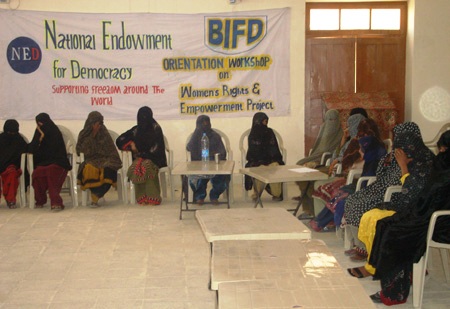



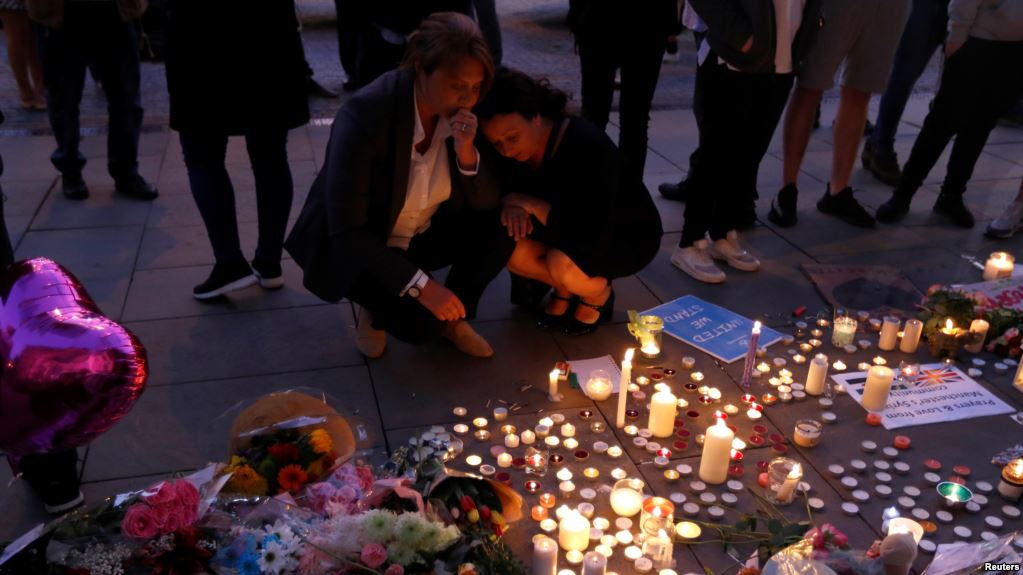
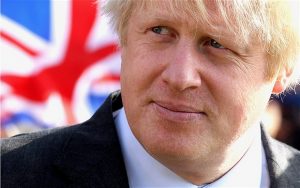

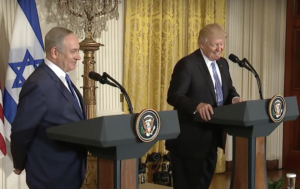





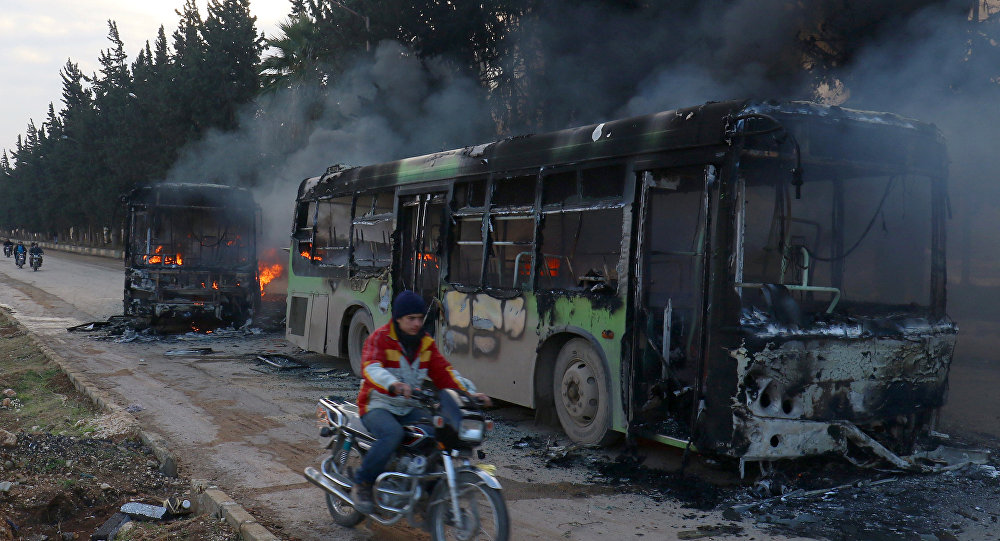
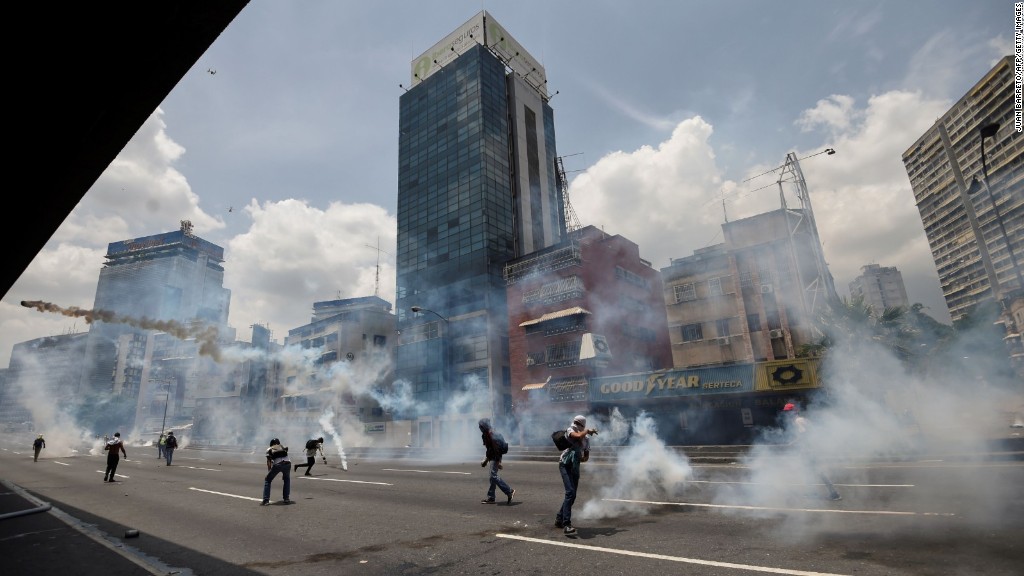
 Visitors to Venezuela now claim that the worst is over and that things are once again improving. It is the ultimate revenge of Hugo Chavez even from the grave he was able to inspire the Venezuelan people to put his ideas into practice.
Visitors to Venezuela now claim that the worst is over and that things are once again improving. It is the ultimate revenge of Hugo Chavez even from the grave he was able to inspire the Venezuelan people to put his ideas into practice.